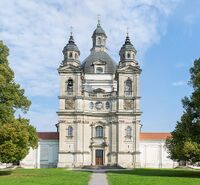Eastern Isles
Federal Territories of the Eastern Isles Bundesterritorien der Östlichen Inseln | |
|---|---|
|
Flag | |
| Motto: The Shinning Coast | |
| Status | Dependency |
| Capital | Kiule |
| Largest | St Bunno City |
| Official languages | Dolch, Raskian |
| Government | Federal Territory |
• Territory Governor | Reiner Schubert |
| Population | |
• Estimate | 67,321 (2022) |
| GDP (nominal) | estimate |
• Total | 1,002,129 |
• Per capita | 14,885 |
The Federal Territories of the Eastern Isles, or simply the Eastern Isles or the acronym FTEI, are a small collective of islands situated on the eastern coast of Baltica. They were formally core territories of the Kingdom and then the Republic of Baltica, having been official territories of the Baltican Royal Family in the 17th century. Now, they are one of only two so called "Federal Regions" of Baltica, being officially administered and ruled by the Baltican Federal Government, although not to the same extent as other Federal Territories, specifically the Ramutia Federal Territory. They continue to operate with some autonomy, electing local majors as well as a Territory Governor. Much of its economy consists of fishing and the small extraction of Natural Gas from Balticas Eastern coast. Collectively the Eastern Isles have a population of 67,000 people, most of whom inhabit the largest island of St Bunno, named after Saint Bunno. The current capital of the Eastern Isles is the city of Kiule, which remains its second largest city, behind Bunostadt.
Etymology
The Eastern Islands get their name from their geographical location along the Eastern Coast of Baltica. Occasionally they are often referred to as the Kezanoi Isles. All three Islands also have their own origins regarding their names. St Bunno Island gets its name from St Bunno, as the Island was conquered during the 20th anniversary of the Saints Death. Singis Island was named after Singe of Belgorta (1634-1689), the then Princes of the Principality of Belgorta. Lastly Rugen Island was named after the then son of the King, King Rugen of Baltica. During the times of the Republic Baltica many anti monarchist politicians rallied to have the Individual names of the Eastern Isles changed in order to remove their monarchist ties. This would have seen Rugen Island renamed to Inseblik whilst Singis Island would be renamed to Ottenlan. However this decision would prove unpopular with the local people of the Islands and the names would be reverted come 1968.
Demographics
Religion
Most inhabitants within the Eastern Isles Identify themselves as Catholics, which is a contrast to the primarily Lutherin population of mainland Baltica. This is mainly a result of the Order of Baltishtin, and its continuing legacy within the islands. Additionally, unlike the mainland people within the Eastern Isles usually find themselves to be much more religious than typical Balticans. A survey in 2018 revealed that over 89% of the Islands population Identify as "Religious Catholics" with only 5% Identifying as Lutheran and 6% as Atheists. Church attendance is also very high among the Eastern Isles, leading to them being a top destination for many aspiring priests and Bishops, and positions on the Islands are often fought over, especially after a new decree in the 2000s made it legal for non-Island citizens to apply for priest positions. This has however made the Islands (Particularly St Bunno Island) a popular destination for pilgrims contributing to the Islands growing tourism trade.
Language
Similarly to a large part of Southern Baltica, people within the Eastern Isles mainly speak the Dolch language. The lack of any original Ras settlements means that the Eastern Isles are one of the few areas which were entirely settled by Dolch. However, despite speaking Dolch, many would consider the Dolch spoken on the Eastern Isles to be a unique language on its own. Many have come to call it "Sailor Dolch", and it can be identified by the larger prevalence placed on the "U" and "O" sounds, which are often pronounced deeper and for longer than within typical Dolch. Additionally, many words exist within "Sailor Dolch" which do not exist in regular Dolch, believed to have originated from rural fishermen which would often communicate in broken Dolch and occasionally invent new words which would catch on. An example of this can be found in words like Fisclunderlin (Fish Monger) and Schelten (Bad) instead of the typical Schlecht. This has proved to be an issue as there is a growing language divide forming between the older population who mainly speak with this "accent" whilst the younger population has been increasingly pushed to learn standard Dolch. As of now, Lake / Amber Dolch has been recognized by the UCAI as a regional language and is a protected language in both the UCAI and Baltica.
Culture
Food
The food found in the Eastern Isles mainly consists of fish. Being very small islands, they typically don't possess enough soil to effectively produce enough agricultural goods to satisfy their needs. This has historically led to many famines, and reliance on shipments from the mainland, especially during the harsh Winter Months. Typical dishes in the Eastern Isles consist of fish and poultry and for many years it was customary for Ravens to be consumed by the population, but this has since been banned. The national dish of the islands is Herring Aspic, which became especially popular during the late 19th century. Other dishes include stuffed pike, pickled eel soup and zander vegetable soup. Besides fish, duck is the primary meat consumed by the citizens of the Eastern Isles, especially the Baltic Black Duck found along the coast of Baltica. Lastly, dairy is also often consumed in the Amber Isles, typically in the form of traditional Baltican Seed Cheese or Baltican sweet cheese which is used as a filling in pastries.


